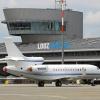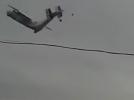LAM E190 over Botswana/Namibia on Nov 29th 2013, captain intentionally crashed aircraft
A LAM Linhas Aereas de Mocambique Embraer ERJ-190, registration C9-EMC performing flight TM-470 from Maputo (Mozambique) to Luanda (Angola) with 27 passengers and 6 crew, was enroute at FL380 over northern Botswana in clear weather when the aircraft suddenly began to descend at about 6000 feet per minute until radar contact and radio contact was lost with the aircraft at about 11:30Z. The aircraft did not arrive in Luanda (scheduled arrival at 14:10L, 13:10Z), the aircraft would have run out of fuel by now. There are no reports of an unscheduled landing anywhere in the region along the flight track. The aircraft was found crashed and burnt down on Namibia's territory in the Bwabwata National Park east of Rundu (Namibia), about 15nm eastsoutheast of Bagani at coordinates S18.1933 E21.8693 with the aircraft's final heading westnorthwest in the general direction to Bagani, the following morning (Nov 30th), no survivors were found.
The following morning (Nov 30th) Namibia's Civil Aviation Authority reported that villagers in the Bwabwata National Park (Sambesi Region) reported the aircraft crashed in their neighbourhood with no survivors. A helicopter has been dispatched on site.
On Nov 30th late morning Namibia's Regional Police reported a rescue team has reached the crash site on the ground, the aircraft has completely burned down, there are no survivors.
On Nov 29th in the afternoon, a few hours after the aircraft disappeared, the airline released a press statement saying that they have information the aircraft landed in Rundu (Namibia) in northern Namibia. The airline and aviation authorities are currently trying to establish contact to verify the information. Late evening the airline stated, they still have no word about the whereabouts of C9-EMC.
Namibia's Authorities have initiated a search for the aircraft confirming the aircraft had been last heard over northern Namibia. The aircraft has not landed on Rundu's Airport. There are unverified reports of the aircraft having gone down 200km/108nm east of Rundu, a national park with mainly wetlands and dense forests.
Mozambique's government said, it can not be ruled out that the aircraft crashed in the border region of Namibia and Botswana, a search for the aircraft is underway in both countries. The search however is hampered by very bad weather in the region and darkness. The government still hopes the aircraft managed a forced landing in the forested area.
On Saturday (Nov 30th) the airline reported the search for the aircraft is ongoing in Botswana, Namibia and Angola. The aircraft carried 10 citizens of Mozambique, 9 Angolans, 5 Portugese, 1 French, 1 Brazilian and 1 Chinese citizen, 1 passenger and the crew not yet listed. As of current Namibian police helicopters are searching the area, that is forested without roads, the search is extremely difficult therefore.
On Nov 30th 2013 Namibia's Regional Authorities of the Kavango Region reported that Authorities in Botswana saw smoke and heard explosions on Friday (Nov 29th) afternoon shortly after the time of loss of contact with the aircraft and informed their Namibian Counterparts. Another short time later villagers sent photos suggesting the aircraft had crashed in the region, due to weather rescue teams were able to reach the crash site on Saturday only.
On Nov 30th 2013 Botswana Authorities reported they originally thought the aircraft had crashed within the boundaries of Botswana, a search was launched. On Friday (Nov 29th) about 15:00L (14:00Z) search personnel observed smoke and explosions on Namibian territory and informed Namibian Authorities.
On Nov 30th 2013 Portugal's Foreign Ministry reported the passenger listed Brazilian has in fact dual citizenship of Portugal and Brazil.
On Nov 30th 2013 14:45Z Mozambique's government, the airline as well as most of Mozambique's media are not reporting the aircraft has been found but still maintain the aircraft is missing. Mozambique's government confirmed however the aircraft was the newest Embraer 190 in LAM's fleet (thus identifying C9-EMC too).
On Nov 30th 2013 rangers of Bwabwata National Park reported that both blackboxes (flight data and cockpit voice recorder) have been found and recovered by accident investigators.
On Nov 30th 2013 17:30L (15:30Z) the airline confirmed the Embraer ERJ-190 tailnumber C9-EMC manufactured in 2012 has crashed killing all 27 passengers (revised from previous day where the airline stated 28 passengers) and 6 crew. The aircraft had entered service with the airline on Nov 17th 2012 and had since accumulated 2905 flight hours in 1877 flight cycles.
On Nov 30th 2013 aviation sources reported that according to radar data the aircraft suddenly started to descend at about 5000 feet per minute until the aircraft disappeared from radar. Radio contact was lost at the same time. The captain of the flight was a senior pilot with over 4000 hours with LAM and also held an instructor rating, the first officer had about 1000 hours of total flight hours with airlines in Mozambique. The captain had repeatedly flown the route.
Late Nov 30th 2013 Mozambique's government confirmed the aircraft crashed in the border area between Botswana and Namibia, authorities in Namibia were informed by Botswana on Friday by about 15:00L (14:00Z) that smoke and explosions were observed by Botswana officials on Namibian soil. Mozambique's government has been informed by Namibia on Saturday that the wreckage has been identified as the remains of C9-EMC, there have been no survivors. An international commission led by Namibia is going to investigate the crash, Brazil (state of manufacture) and Mozambique (state of operator) are going to participate in the investigation. A preliminary report is anticipated within 30 days according to ICAO rules. Mozambique's government established a second commission to examine the Civil Aviation Authority of Mozambique and the airline LAM.
According to information provided by Namibia's lead investigator the aircraft was enroute at FL380 when it began to descend at about 100 feet per second (6000 feet per minute), it remained visible on radar until about 3000 feet MSL. The two boxes recovered from the aircraft were the cockpit voice recorder and one ELT, the flight data recorder however is still missing.
On Dec 1st 2013 the airline reported both captain and first officer held Air Transport Pilot Licenses, the captain had accumulated 9,053 hours total experience with 1,395 hours in command, the first officer had accumulated 1,418 hours of flying experience. The aircraft had undergone its last inspection on Nov 28th 2013. The investigation is being led by Namibia, Authorities of Mozambique, Angola, Brazil and the USA joined the investigation.
Pilots based at Bagani Airstrip (Namibia) about 10nm west of the crash site, reported on their Facebook page "Pirots of the Namibian", that the weather was clear all day on Friday (Nov 29th), Metars of Maun (Botswana) 140nm south of the crash site, confirm that weather report (see below).
On Dec 3rd 2013 the lead investigator said, both recorders have been recovered, flight data and cockpit voice data are being read out. A commission of 30 investigators from Namibia, Mozambique, Brazil, Angola and the USA met in Windhoek (Namibia's capital) and is heading to the crash site. Another group in Windhoek currently identifies the remains of the victims. In compliance with ICAO rules a preliminary report is to be expected within 30 days.
On Dec 4th 2013 the lead investigator said, the black boxes will be read and analysed by the NTSB. The accident board has collected radar data and weather data. There was no distress call.
On Dec 5th 2013 the Pirots of the Namibian told The Aviation Herald: "At time of the crash the weather was fine as far as we could see at Bagani – our view towards the SE was obstructed by tree so that limited what we could see there. We (2 crew) flew ... to Windhoek via Rundu at 17:45L that afternoon and by that time there were several heavy downpours and regular lightning in the area especially towards the East. On the way to Rundu we had to fly around a few of these. We later heard the SAR helicopter returning to base at around sunset and I am not surprised that they had to abort the mission due to weather – it was getting worse quickly when we left Bagani." The Pirots could not comment on thunderstorm cells around or near the airway at the time of the accident, however, when they attempted to contact Gaborone Control at FL115 near the crash site, they were unable to establish contact and had been off Windhoek Radar for a while.
On Dec 12th 2013 reader Simon, meteorologist at a highly reputed university in the USA, submitted true colour satellite images (see below), that were taken by Eumetsat on the day of the crash at 11:15Z and 11:30Z. Reader Simon reported that he had never seen such a rapidly developing thunderstorm cell before. At 11:15Z that cell was located about 15nm to the right of the airway at position S19.398 E23.369 about 111nm from the crash site, most likely created updrafts in excess of 60 meters/second (117+ knots vertical), provided ice crystal icing conditions and grew its tops rapidly from about FL260 to FL420 within 30 minutes and falling back to FL300 again in another 30 minutes (at 12:00Z). A smaller cell was almost over the airway at position S19.493 E23.017 about 101nm from the crash site also creating ice crystal icing conditions and probably producing updrafts around 55 meters/second (107 knots vertical speed).
On Dec 14th 2013 Mozambique's Civil Aviation Authority reported in a press conference, that the investigation is well underway, cockpit voice and flight data recorder have been successfully read out and have been analysed, a preliminary report is nearly finished. Results of the investigation so far rule out any mechanical problem or problem with the airworthiness of the aircraft as cause of the major accident.
On Dec 21st 2013 Mozambique's Civil Aviation Authority reported in a press conference (the preliminary report has not yet been released by Namibia's Accident Investigation Commission), that cockpit voice recorder and flight data recorder revealed, that the captain was alone on the flight deck, banging on the flight deck door could be heard on the cockpit voice recorder. The autoflight systems (autothrottle and autopilot) were engaged. There were sounds and clicks consistent with a person knowledgeable of the aircraft systems commanding the engines to idle thrust and selecting the autoflight systems into a descent at 6000 feet per minute. Numerous warnings and alerts were not responded to.
The airline operates 3 Embraer ERJ-190 registrations C9-EMA, C9-EMB and C9-EMC. The airline also operates two Embraer ERJ-145, two Boeing 737-200s (which are already phased out however) and one Boeing 737-500. The subsidiary Mocambique Express operates 3 Embraer EMB-120 and 3 de Havilland Dash 8-400s.
Metars at Maun (Botswana) about 140nm south of the crash site:
FBMN 291500Z 04006KT 9999 FEW030 35/11 Q1011
FBMN 291400Z 06004KT 9999 FEW030 35/12 Q1011
FBMN 291300Z 10007KT 9999 FEW030 34/12 Q1012
FBMN 291200Z 09008KT CAVOK 33/13 Q1014
FBMN 291100Z 14011KT CAVOK 32/14 Q1015
FBMN 291000Z 16012KT 8000 29/15 Q1017
FBMN 290900Z 17007KT CAVOK 3014 Q1017
FBMN 290900Z 17007KT CAVOK 30/14 Q1017
Aerial view of crash site approx 15nm ESE of Bangani, view to the north (Photo: Pirots of the Namibian):
Detail of final position in view to eastsoutheast (Photo: Pirots of the Namibian):
Detail of first impact in view to eastsoutheast (Photo: Pirots of the Namibian):
Aerial view of crash site approx 15nm ESE of Bangani, view to the eastsoutheast (Photo: Pirots of the Namibian):
Detail of first impact out of view towards Bagani (Photo: Pirots of the Namibian):
Aerial view of crash site approx 15nm ESE of Bagani, view toards Bagani (Photo: Pirots of the Namibian):
Crash site, seen towards point of first impact (Photo: AP/Olavi Haikera):
The remains (Photo: AP/Olavi Haikera):
True Colour Image Nov 29th 11:30Z (Photo: AVH/Reader Simon/Eumetsat):
True Colour Image Nov 29th 11:15Z (Photo: AVH/Reader Simon/Eumetsat):
Infrared Satellite Image SEVIRI Nov 29th 12:00Z (Photo: Meteosat):
Detail Map (Graphics: AVH/Google Earth):
Map (Graphics: AVH/Google Earth):
http://avherald.com/h?article=46c3abde














Komentarze